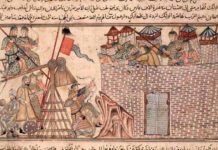Imelda Marcos’s obsession with beauty and fashion has dominated her whole life. The former First Lady was called the Marie-Antoinette of the twentieth century.
She and her husband, President Ferdinand Marcos, were accused of stealing billions from the country, torturing political prisoners, nepotism, corruption, and many other atrocities. However, even a midnight flight from the capital, Manila, in the face of a ‘People’s Revolution’ didn’t diminish Imelda’s love of fashion and extravagance.
Imelda Marcos’s Rise To Power
Imelda rose to power fast. She won a beauty contest in 1954 and after an 11-day courtship married the ambitious politician, Ferdinand Marcos, in 1954. During his presidency he imposed Martial Law on the Philippines and kept a tight grip on power. Imelda was given various roles as well, including the Governorship of Metropolitan Manila, and often acted as an ambassador for the Philippines. She was nicknamed ‘the Iron Butterfly’. She commissioned luxury hotels and a cultural center and focused her attention on increasing tourism to the country, ignoring the terrible poverty and huge difference in lifestyles between the wealthy and the poor.
Imelda Marcos’s Taste for Luxury
The assassination of Senator Benigno Aquino, Jr. began the fall from power of the Marcos’s. When they were believed responsible for this by many of the people, they fled to Hawaii, leaving behind them the evidence of their greed and liking for luxury. Imelda was believed to have over 1000 pairs of shoes in her closet; several silk dresses; quart and gallon size bottles of the most expensive French perfumes; and luxurious scented soaps. She escaped with her jewelry, however, taking diamonds wrapped in nappies to Hawaii. She was supposed to have over $13 million dollars worth of jewelry.
Imelda didn’t worry about her taste for luxury. She said in interviews with CNN and The Business Inquirer Network that: “…At least when they went into my closets they found shoes not skeletons.” She did admit that: “…They will use Imeldific to mean ostentatious extravagance,” but seemed proud of this fact.
The obsession with shoes and designer fashion which seems to afflict many is called ‘Imelda Marcos Syndrome’.
While she was the First Lady Imelda used her fascination with beauty and femininity to her advantage. She combined her natural Asian characteristics with a Western perception of Asian womanhood – sweet, accessible and welcoming. She also made good use of the baro’t saya‘ – a Filippino style-dress which is long and clinging with butterfly sleeves to reinforce the perception that she wanted to promote the country’s culture.
Edifice Complex: The Architecture of the Marcos’s
Like many dictators, Marcos has been accused of having an ‘edifice complex’ and she certainly used architecture to promote her power. When Ferdinand Marcos introduced Martial Law he also introduced what he called a ‘new social order’ to the Philippines. The large, concrete buildings Imelda commissioned were part of the Marcos’s idea of rejuvenating cultural identity in the Philippines. According to the book ‘Edifice Complex’ by Gerard Lico the Marcos’s presented themselves as parental figures and had self-glorifying projects such as sculptures and paintings. Imelda even traced her genealogy back to Rome.
The huge Cultural Center complex was huge and included major museums – Art and Costume, for example. It focused on exhibits of the indigenous people of the Philippines and combined Western-style architecture with Filipino materials. There were also recreations of familiar geological landmarks, such as the Ifugao Rice Terraces and the Mayon Volcano, on a smaller scale. Natural materials used in construction included coconut tree lumber. The Marcos’s reclaimed land from the sea and used the land allegedly owned by the indigenous peoples in order to build many of their huge construction projects but they gave the impression that they were also protecting and promoting them by using their symbols, materials and traditional designs.
The fate of the Film Center shows the great ambitions and ‘delusions of grandeur’ of the Marcos regime. Imelda and Marcos changed the building plans causing delays. When it had to be completed in a hurry for the international film festival it collapsed, causing the death of several workers. The ugly concrete building has been somewhat restored but there is a myth that the ghosts of the workers haunt it.
It is ironic that many of the buildings constructed during the regime are now tourist attractions for different reasons than the Marcos’s intended. Symbols of extravagance and grandiosity, they are popular sights on the tourist trail. There is even a museum dedicated to Imelda’s shoes, including shoes by local designers as well as internationally famous ones such as Chanel and Magli.
Sources:
- “Book Review: Edifice Complex: Power, Myth and the Marcos State Architecture”, Lico, Gerard. The Arts of the Philippines
- “Imelda Marcos Talkasia Transcript”, CNN.com
- “Imelda Marcos Still Quite A Lady At 78”, Wilson, Karl. The Inquirer Network








